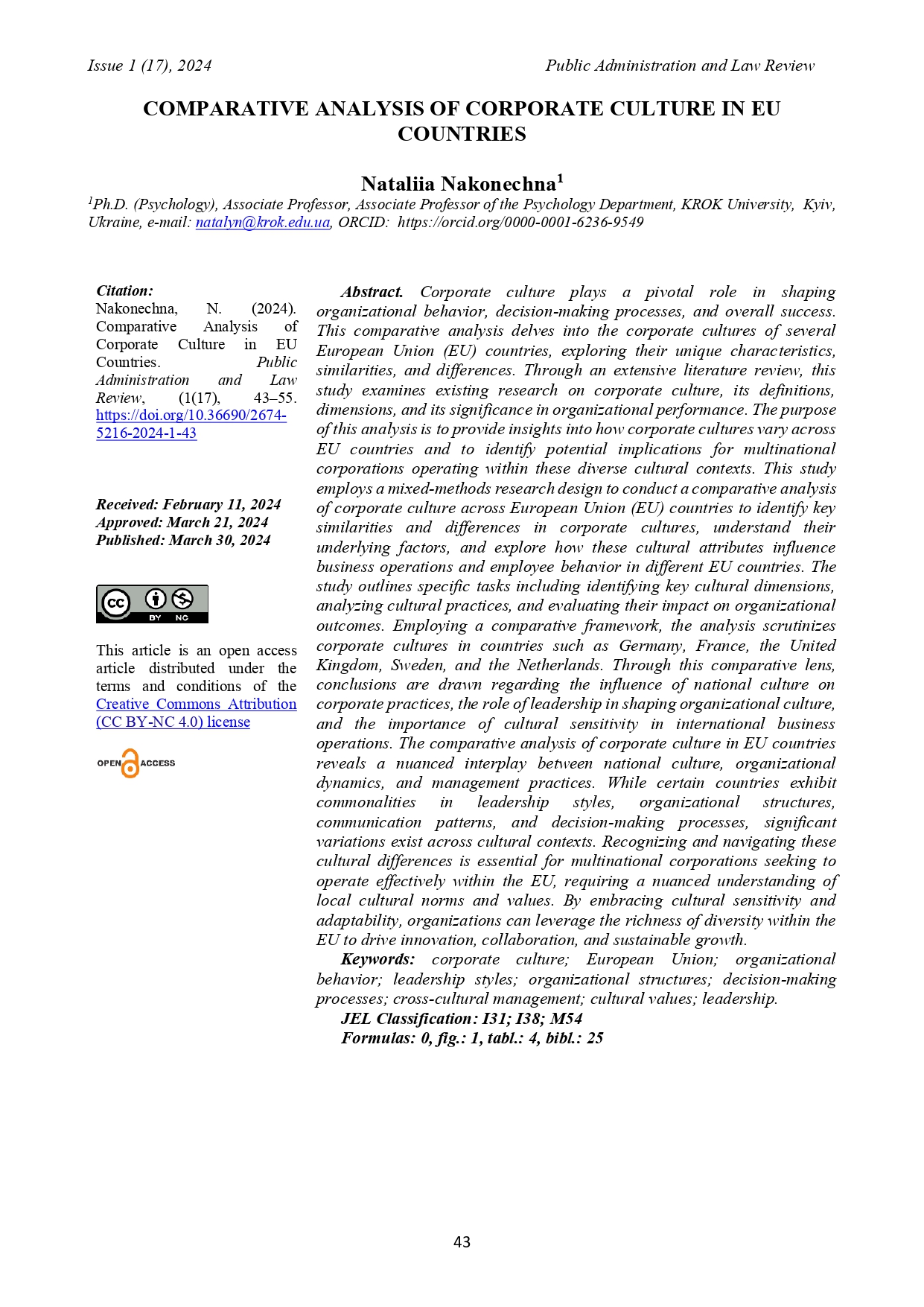COMPARATIVE ANALYSIS OF CORPORATE CULTURE IN EU COUNTRIES
DOI:
https://doi.org/10.36690/2674-5216-2024-1-43Keywords:
corporate culture, european union, organizational behavior, leadership styles, organizational structures, decision-making processes, cross-cultural management, cultural values, leadershipAbstract
Corporate culture plays a pivotal role in shaping organizational behavior, decision-making processes, and overall success. This comparative analysis delves into the corporate cultures of several European Union (EU) countries, exploring their unique characteristics, similarities, and differences. Through an extensive literature review, this study examines existing research on corporate culture, its definitions, dimensions, and its significance in organizational performance. The purpose of this analysis is to provide insights into how corporate cultures vary across EU countries and to identify potential implications for multinational corporations operating within these diverse cultural contexts. The study outlines specific tasks including identifying key cultural dimensions, analyzing cultural practices, and evaluating their impact on organizational outcomes. Employing a comparative framework, the analysis scrutinizes corporate cultures in countries such as Germany, France, the United Kingdom, Sweden, and the Netherlands. Through this comparative lens, conclusions are drawn regarding the influence of national culture on corporate practices, the role of leadership in shaping organizational culture, and the importance of cultural sensitivity in international business operations. This study contributes to a deeper understanding of the complexities of corporate culture within the EU, offering valuable insights for organizations seeking to navigate the challenges of cross-cultural management.
Downloads
References
Hofstede, G. (2001). Culture's consequences: Comparing values, behaviors, institutions, and organizations across nations. Sage.
Schein, E. H. (1985). Organizational culture and leadership. Jossey-Bass.
Trompenaars, F., & Hampden-Turner, C. (1998). Riding the waves of culture: Understanding diversity in global business. Nicholas Brealey Publishing.
House, R. J., Hanges, P. J., Javidan, M., Dorfman, P. W., & Gupta, V. (2004). Culture, leadership, and organizations: The GLOBE study of 62 societies. Sage.
Cox, T. (1994). Cultural diversity in organizations: Theory, research, and practice. Berrett-Koehler Publishers.
Hofstede, G., & Minkov, M. (2010). Cultures and organizations: Software of the mind. McGraw-Hill.
Hofstede, G. (1980). Culture's consequences: International differences in work-related values (Vol. 5). Sage.
Cameron, K. S., & Quinn, R. E. (2011). Diagnosing and changing organizational culture: Based on the competing values framework. John Wiley & Sons.
Erez, M., & Gati, E. (2004). A dynamic, multi-level model of culture: From the micro level of the individual to the macro level of a global culture. Applied Psychology, 53(4), 583-598.
House, R. J., Wright, N. S., & Aditya, R. N. (1997). Cross-cultural research on organizational leadership: A critical analysis and a proposed theory. In Handbook of organizational culture & climate (pp. 657-692). Sage.
Hofstede, G., Hofstede, G. J., & Minkov, M. (1991). Cultures and organizations: Software of the mind. McGraw-Hill.
Ronen, S., & Shenkar, O. (1985). Clustering countries on attitudinal dimensions: A review and synthesis. Academy of Management Review, 10(3), 435-454.
Maznevski, M. L., DiStefano, J. J., Gomez, C. B., Noorderhaven, N. G., & Wu, P. C. (2002). Cultural dimensions at the individual level of analysis: The cultural orientations framework. International Journal of Cross Cultural Management, 2(3), 275-295.
Hofstede, G., Hofstede, G. J., & Minkov, M. (2010). Cultures and organizations: Software of the mind. McGraw-Hill.
Trompenaars, F., & Hampden-Turner, C. (2012). Riding the waves of culture: Understanding diversity in global business. Nicholas Brealey Publishing.
Ouchi, W. G. (1981). Theory Z: How American business can meet the Japanese challenge. Addison-Wesley.
Adler, N. J. (1997). International dimensions of organizational behavior. South-Western College Pub.
Nohria, N., & Ghoshal, S. (1997). The differentiated network: Organizing multinational corporations for value creation. San Francisco: Jossey-Bass.
Pascale, R. T., & Athos, A. G. (1981). The art of Japanese management. Penguin Books.
Egelhoff, W. G. (1982). Patterns of organization structure in East Asia. Administrative Science Quarterly, 327-343.
Trompenaars, F., & Hampden-Turner, C. (2011). Riding the waves of culture: Understanding diversity in global business. Nicholas Brealey Publishing.
Hofstede, G., Hofstede, G. J., & Minkov, M. (2013). Cultures and organizations: Software of the mind. McGraw-Hill.
Hofstede, G., & Hofstede, G. J. (2005). Cultures and organizations: Software of the mind (Vol. 2). McGraw-Hill.
Hall, E. T. (1976). Beyond culture. Anchor Press.
Geertz, C. (1973). The interpretation of cultures: Selected essays. Basic Books.

Downloads
Published
How to Cite
Issue
Section
License

This work is licensed under a Creative Commons Attribution-NoDerivatives 4.0 International License.





